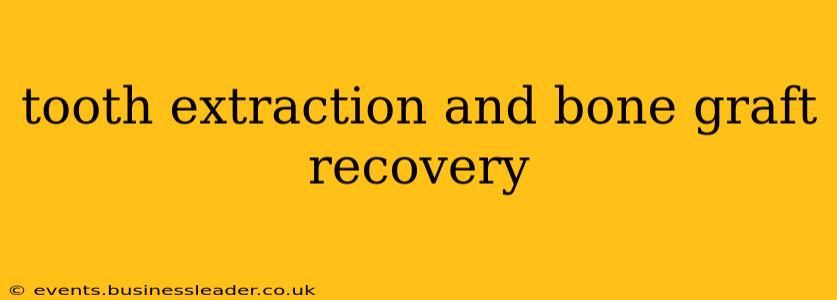Losing a tooth is never easy, but modern dentistry offers solutions to restore both your smile and oral health. One common procedure involves tooth extraction followed by a bone graft. This guide delves into the recovery process, addressing common questions and concerns to help you navigate this journey successfully.
What is a Bone Graft After Tooth Extraction?
A bone graft is a surgical procedure where bone material is added to the jawbone. This is often necessary after a tooth extraction, particularly in cases where significant bone loss has occurred. The grafted bone helps to:
- Preserve Jawbone Structure: The jawbone naturally recedes over time, especially after tooth loss. A bone graft prevents further bone loss and maintains the structural integrity of your jaw.
- Support Future Dental Implants: If you plan to get dental implants to replace the extracted tooth, a bone graft provides the necessary foundation for successful implant placement. Insufficient bone density can prevent successful implant integration.
- Improve the Aesthetics of your Smile: Bone loss can lead to changes in facial contours. A bone graft can help maintain the natural shape and appearance of your jawline and face.
The bone graft material can come from various sources, including your own body (autograft), a donor (allograft), or synthetic materials (xenograft or alloplast). Your dentist will determine the best type of graft based on your individual needs and the extent of bone loss.
What are the Stages of Recovery After a Tooth Extraction and Bone Graft?
Recovery after a tooth extraction and bone graft involves several stages, each with unique considerations:
Immediate Post-Operative Period (First 24-48 hours):
- Bleeding: Some bleeding is normal. Apply firm pressure to the extraction site using a gauze pad as instructed by your dentist.
- Swelling: Swelling and bruising are common and may peak within 2-3 days. Applying ice packs to the affected area can help minimize swelling.
- Pain: Pain medication prescribed by your dentist will help manage discomfort.
- Diet: Stick to a soft food diet for the first few days. Avoid hot foods and drinks.
First Week:
- Gradual Improvement: You should notice a gradual reduction in pain, swelling, and bleeding.
- Oral Hygiene: Gently rinse your mouth with saltwater several times a day to promote healing. Avoid brushing directly over the extraction site for the first few days.
- Follow-up Appointment: Attend your scheduled follow-up appointment with your dentist to monitor healing progress.
Weeks 2-6:
- Continued Healing: The bone graft will continue to integrate with your existing jawbone.
- Stitches (if any): Stitches will likely be removed at a follow-up appointment.
- Diet Expansion: You can gradually increase the variety and texture of your food as tolerated.
Months 2-6 and Beyond:
- Complete Healing: Bone graft integration is usually complete within 6 months, although this can vary depending on individual factors.
- Implant Placement (if applicable): Once the bone graft has fully integrated, your dentist may proceed with dental implant placement.
How Long Does it Take to Recover From a Tooth Extraction and Bone Graft?
The recovery time varies from person to person, but complete healing generally takes several months. Factors influencing recovery include the extent of bone loss, the type of bone graft used, and individual healing capacity. Most patients experience significant improvement within the first few weeks, but full integration of the bone graft can take 6 months or longer.
What are the Potential Complications of a Tooth Extraction and Bone Graft?
While generally safe, tooth extraction and bone grafting carry potential risks, such as:
- Infection: Maintaining good oral hygiene is crucial to prevent infection.
- Dry Socket: This occurs when the blood clot at the extraction site dislodges prematurely.
- Nerve Damage: Rarely, nerve damage can occur during the procedure, causing numbness or tingling.
- Bone Graft Failure: In some cases, the bone graft may not fully integrate with the jawbone.
What are the Dos and Don'ts After a Tooth Extraction and Bone Graft?
Dos:
- Follow your dentist's instructions carefully.
- Take prescribed pain medication as directed.
- Apply ice packs to reduce swelling.
- Rinse your mouth gently with saltwater.
- Eat a soft food diet initially.
- Attend all follow-up appointments.
Don'ts:
- Smoke.
- Drink through a straw.
- Rinse your mouth vigorously.
- Touch or probe the extraction site.
- Engage in strenuous activities.
Can I Smoke After a Tooth Extraction and Bone Graft?
No, smoking is strongly discouraged after a tooth extraction and bone graft. Smoking significantly impairs healing and increases the risk of infection and dry socket. The nicotine in cigarettes constricts blood vessels, reducing blood flow to the extraction site, hindering the healing process.
What Foods Can I Eat After a Tooth Extraction and Bone Graft?
Focus on soft, nutritious foods initially, such as yogurt, applesauce, mashed potatoes, and smoothies. As healing progresses, you can gradually introduce more solid foods. Avoid hard, crunchy, or chewy foods that could irritate the extraction site.
What Should I Do If I Experience Excessive Pain or Swelling?
Contact your dentist immediately if you experience excessive pain, swelling, or any other concerning symptoms.
This guide provides general information and should not be considered medical advice. Always consult with your dentist or oral surgeon for personalized guidance regarding your specific situation. Remember, proper post-operative care is crucial for a successful outcome.
